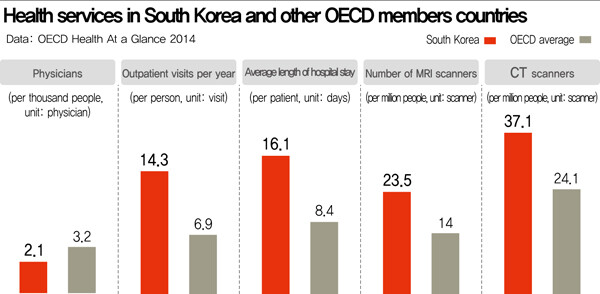hankyoreh
Links to other country sites 다른 나라 사이트 링크
Hospital patients waiting longer, paying for more expensive tests

“I wait thirty minutes to an hour for a consultation, and once I go in the room it’s hard to even make eye contact with the doctor. It’s tough to even see the opinion or the imaging test results, let alone ask any questions.”
The fiftysomething man was recalling his experience visiting a Seoul-area university hospital (high-level general hospital) for diabetes treatment.
“It takes about an hour to get to the hospital from home, but I go there anyway because they‘re university hospital professors and they’re trustworthy,” he explained.
A professor at one Seoul university hospital shared the internal medicine treatment situation there.
“You sometimes see as many as 120 or more people for outpatient treatment just during the four morning hours,” the professor said. “It’s so densely packed we barely have the time to ask necessary questions about drug side effects or explain about the necessary testing.”
“One of the criticisms of high-level general hospitals is that they do a lot of expensive imaging and blood tests, but a lot of times that’s what the patient wants too,” the professor added.
The so-called “three-minute consultation” situation at high-level general hospitals has recently become an increasingly serious problem. As more and more South Korean patients flock to large hospitals, the result has been a situation where many receive costly testing without adequate explanations from their physicians.
An examination of OECD public health and medical treatment statistics for 2014 showed South Korea with a low number of physicians relative to its population, but high numbers of outpatient consultations and long hospital stays. It also topped the OECD for costly examination equipment.
As of 2012, South Korea had 2.1 physicians for every 1,000 people, or 66% the OECD average of 3.2. But per capita outpatient visits amounted to 14.3 per year, the highest level in the OECD and more than double its average of 6.9. Hospital stays averaged 16.1 days for South Korean patients, or 1.9 times the OECD average of 8.4 days. South Korea also had 23.5 magnetic resonance imaging (MRI) scanners for every million people, or 9.5 more than the OECD average of 14, and 37.1 computerized axial tomography (CAT) scanners, or 13 more than the average of 24.1.
The low number of physicians and high number of hospital visits has resulted in a vicious cycle in which patients are unable to receive adequate explanations from their doctors, leading them to visit other doctors or opt for many expensive tests.
National Health Insurance Service statistics showed outpatient visits accounting for 31.3% of total revenue from health insurance treatment at high-level general hospitals - up from 21.5% in 2003. The percentage of visits to neighborhood clinics fell from 45.5% to 27.5% over the same period.
By Kim Yang-joong, medical correspondent
Please direct questions or comments to [english@hani.co.kr]

Editorial・opinion
![[Column] Has Korea, too, crossed the Rubicon on China? [Column] Has Korea, too, crossed the Rubicon on China?](https://flexible.img.hani.co.kr/flexible/normal/500/300/imgdb/original/2024/0419/9317135153409185.jpg) [Column] Has Korea, too, crossed the Rubicon on China?
[Column] Has Korea, too, crossed the Rubicon on China?![[Correspondent’s column] In Japan’s alliance with US, echoes of its past alliances with UK [Correspondent’s column] In Japan’s alliance with US, echoes of its past alliances with UK](https://flexible.img.hani.co.kr/flexible/normal/500/300/imgdb/original/2024/0419/2317135166563519.jpg) [Correspondent’s column] In Japan’s alliance with US, echoes of its past alliances with UK
[Correspondent’s column] In Japan’s alliance with US, echoes of its past alliances with UK- [Editorial] Does Yoon think the Korean public is wrong?
- [Editorial] As it bolsters its alliance with US, Japan must be accountable for past
- [Guest essay] Amending the Constitution is Yoon’s key to leaving office in public’s good graces
- [Editorial] 10 years on, lessons of Sewol tragedy must never be forgotten
- [Column] A death blow to Korea’s prosecutor politics
- [Correspondent’s column] The US and the end of Japanese pacifism
- [Guest essay] How Korea turned its trainee doctors into monsters
- [Guest essay] As someone who helped forge Seoul-Moscow ties, their status today troubles me
Most viewed articles
- 1[Column] The clock is ticking for Korea’s first lady
- 2After 2 months of delayed, denied medical care, Koreans worry worst may be yet to come
- 3Hong Se-hwa, voice for tolerance whose memoir of exile touched a chord, dies at 76
- 4[Column] Has Korea, too, crossed the Rubicon on China?
- 5[Correspondent’s column] In Japan’s alliance with US, echoes of its past alliances with UK
- 6Samsung barricades office as unionized workers strike for better conditions
- 7All eyes on Xiaomi after it pulls off EV that Apple couldn’t
- 8[Editorial] As it bolsters its alliance with US, Japan must be accountable for past
- 9[News analysis] After elections, prosecutorial reform will likely make legislative agenda
- 10US overtakes China as Korea’s top export market, prompting trade sanction jitters